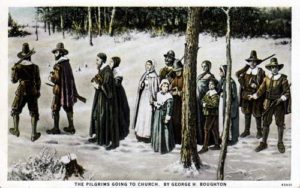In the year 1627, William Bradford relates that the Pilgrims built a trading post to “avoid the compassing of Cape Cod and those dangerous shoals, and so make any voyage to the southward in much shorter time and with far less danger.”
The Pilgrims had to go by boat down to Scusset River, and then carry their boat and goods several miles to the Manomet river that flows into Buzzards Bay in the present town of Bourne in order to avoid going around the Cape.
The Dutch, Natives and English traded in a free market with a currency known as “wampum” made from quahog shells. The white and purple colors were valued differently, and in many aspects this was America’s first currency. It made all three cultures wealthier. Since the Natives called the place Aptuxet, the Aptuxet Trading Post is its name today. The interesting providences are three-fold.
1. As a result of trade negotiations that eventually resulted in the Aptuxet Trading Post, Myles Standish and William Bradford, in the year 1623, thought of the need for a canal between the Scusset and Manomet rivers (over a mile over land). That dream became a reality July 29, 1914 when the Cape Cod Canal was actually completed.
 2. As a result of the building built in 1627, a Dutch trader by the name of Isaac DeRasieres came to visit Plimoth Plantation in the same year. As a visitor, and possibly a spy, he noted how the Pilgrims went to church, stating “They assemble by beat of drum, each with his musket or firelock, in front of the captain’s door; they have their cloaks on, and place themselves in order, three abreast, and are led by a sergeant without beat of drum. Behind comes the Governor, in a long robe; beside him on the right hand, comes the preacher with his cloak on, and on the left hand, the captain with his side-arms and cloak on, and with a small cane in his hand; and so they march in good order, until each sets his arms down near him. Thus they are constantly on their guard night and day.” Without this eye-witness account, we would have no iconic image of the pilgrims going to church, and no Pilgrim Progress re-enacting such a scene today.
2. As a result of the building built in 1627, a Dutch trader by the name of Isaac DeRasieres came to visit Plimoth Plantation in the same year. As a visitor, and possibly a spy, he noted how the Pilgrims went to church, stating “They assemble by beat of drum, each with his musket or firelock, in front of the captain’s door; they have their cloaks on, and place themselves in order, three abreast, and are led by a sergeant without beat of drum. Behind comes the Governor, in a long robe; beside him on the right hand, comes the preacher with his cloak on, and on the left hand, the captain with his side-arms and cloak on, and with a small cane in his hand; and so they march in good order, until each sets his arms down near him. Thus they are constantly on their guard night and day.” Without this eye-witness account, we would have no iconic image of the pilgrims going to church, and no Pilgrim Progress re-enacting such a scene today.
3. If there had been no Aptuxet Trading Post, we would have no monument to the origin of the free economy practiced by the pilgrims today. The original foundation upon which the Trading Post was constructed was partially excavated in 1852 but then completed beginning in 1926. The restored building on its original foundation is probably the oldest pilgrim foundation still visible today.







